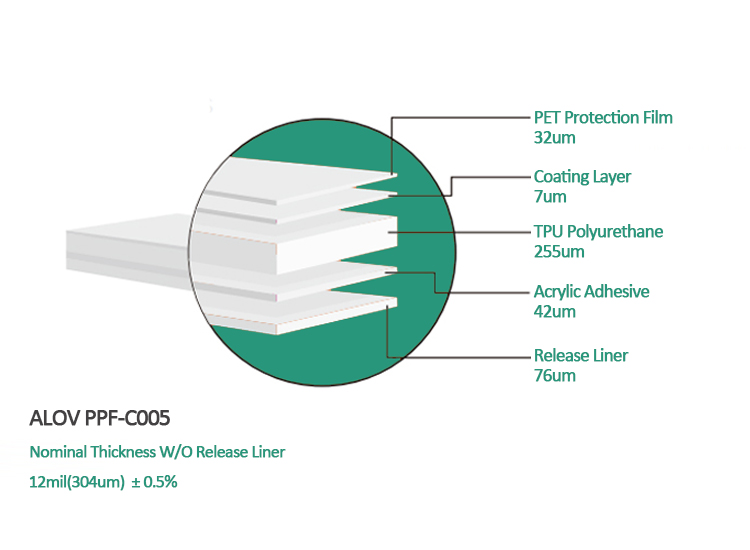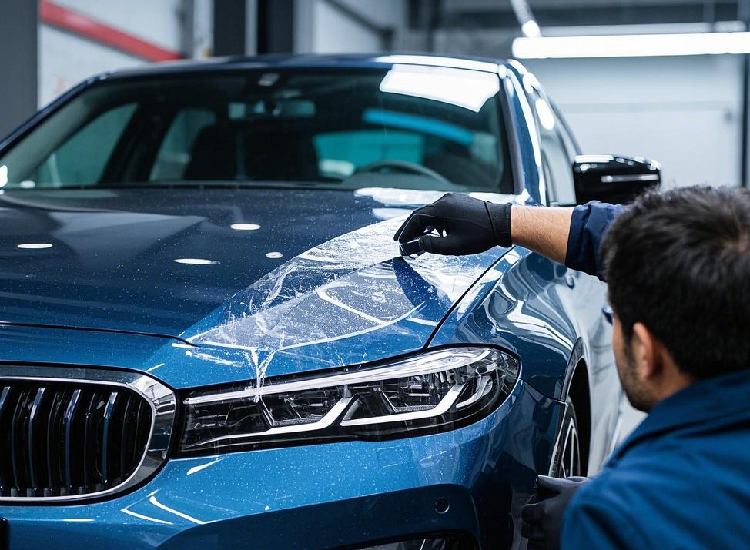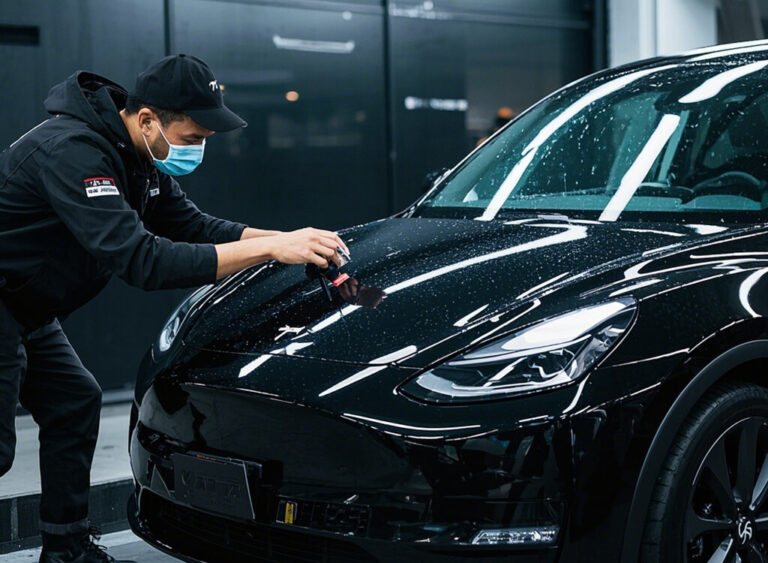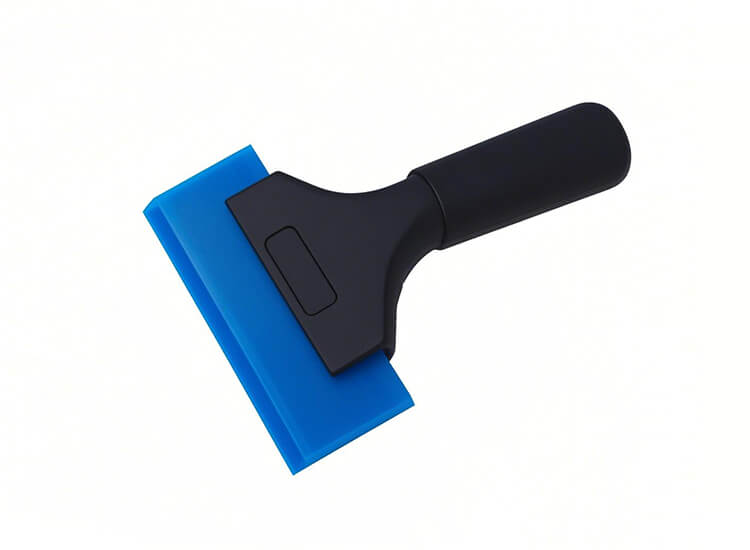Choose the Right Paint Protection Film(PPF) Thickness for Maximum Car Protection
Nowadays, cars are more than just a way to get around—they’re a valuable asset. Preserving its paint from scratches, rock chips, and environmental wear is key to keeping its resale value high. One of the best ways to protect your vehicle’s finish is with Paint Protection Film (PPF). But not all PPFs provide the same level of defense, and thickness plays a crucial role in performance. In this guide, we’ll explore why PPF thickness matters, how it impacts durability, and how to select the right option for your car.

Why Paint Protection Film Thickness Matters?
PPF thickness plays a crucial role in determining how well it protects your vehicle’s paint. Generally, Paint Protection Films range from 6 to 12 mils in thickness. The thicker the film, the more resistant it is to scratches, rock chips, and UV damage. However, going too thick may compromise flexibility and aesthetic appeal.
How Many Layers Are in PPF?
PPF is composed of multiple layers, each designed to provide specific protective properties. Typically, high-quality PPF consists of three to five layers(PPF Structure):
-
Top Coat Layer – This is a self-healing, stain-resistant, and UV-resistant layer that helps maintain the film’s clarity and durability over time. It prevents discoloration and enhances the film’s longevity.
-
Polyurethane (PU) or Thermoplastic Polyurethane (TPU) Layer – This is the core of the PPF, offering impact resistance against road debris, scratches, and environmental contaminants. High-end PPFs use TPU for its superior flexibility and self-healing capabilities.
-
Adhesive Layer – This layer ensures strong adhesion to the vehicle’s surface without damaging the paint. Advanced adhesives allow easy repositioning during installation and prevent residue upon removal.
-
Release Liner (Optional Layer) – Some films come with a release liner that protects the adhesive before installation. This layer is removed during application.
-
Bottom Protective Layer (Optional) – Some premium PPFs include an extra layer for additional impact absorption or enhanced bonding.

How Different Thickness Levels Affect Protection:
-
6/6.5 mils – Provides basic protection against minor scratches and environmental contaminants.
- 7.5 mils – Low cost investment but offers good car paint protection.
-
8 mils – Offers a balance between flexibility and durability, making it suitable for most vehicles.
-
10 mils – Delivers superior protection against road debris, ideal for high-performance and luxury vehicles.
-
12 mils – Maximum impact resistance, best for off-road vehicles and commercial fleets exposed to extreme conditions.
Choosing the right thickness depends on how you use your car and the driving conditions you encounter regularly.
Is 6.5 mil PPF good or is 7 mil PPF enough?
Based on feedback from a majority of paint protection installers, 7.5 mil PPF is considered to offer superior protection against scratches, dings, and other types of minor damage. This thickness provides an extra layer of durability that helps keep your vehicle looking pristine for a longer period. A high-quality PPF film should ideally have a minimum thickness of 6.5 mils to ensure that it can deliver sufficient protection for your car’s paint. Anything thinner than that may not provide the same level of defense against the daily wear and tear your vehicle encounters.

What Is The Difference Between 8 mil and 10 mil PPF?
When choosing between 8 mil and 10 mil Paint Protection Film (PPF), understanding the key differences can help you select the best option for your needs. The term “mil” refers to the thickness of the film, with one mil being equal to 0.001 inches. An 8 mil PPF offers a balance of durability and flexibility, ideal for protecting vehicles from minor scratches, dirt, and road debris. On the other hand, a 10 mil PPF is thicker and provides extra protection against more severe impacts, such as rock chips and abrasions. While both thicknesses offer superior protection, the 10mil film is typically more durable and better suited for high-traffic areas or harsher driving conditions. Understanding these distinctions will allow you to make an informed decision based on your specific protection needs.
Key Factors to Consider When Choosing PPF Thickness
Selecting the right paint protection film (PPF) thickness is crucial for balancing durability, protection, and aesthetics. The ideal thickness depends on factors such as driving conditions, vehicle type, and the level of protection required. A thicker PPF offers superior defense against stone chips, scratches, and road debris, making it ideal for high-impact areas. However, thinner films provide a nearly invisible finish while still offering moderate protection. Additionally, self-healing properties, UV resistance, and installation quality play a significant role in long-term performance. Understanding these key factors helps ensure the best choice for preserving your vehicle’s paint and resale value.
Driving Conditions and Usage
The environment in which you drive greatly impacts the level of protection your car needs.
-
City Driving: If you mainly drive in urban areas with well-maintained roads, a 6 to 8 mil PPF should be enough to protect against minor abrasions.
-
Highway Driving: Vehicles exposed to high speeds and frequent road debris should have a 8 to 10 mil PPF for enhanced durability.
-
Off-Road or Harsh Conditions: If you frequently drive on gravel roads, mountainous terrain, or areas with extreme weather, 10 to 12 mil PPF will provide the best defense.
Self-Healing Technology
Many modern PPFs feature self-healing properties, allowing minor scratches and swirl marks to disappear with heat or sunlight. This feature is particularly useful for maintaining a car’s showroom appearance over time.
Aesthetic Preferences: High-Gloss vs. Matte Finish
PPF isn’t just about protection—it also affects your car’s appearance.
-
High-Gloss PPF enhances the original shine of your vehicle’s paint, giving it a sleek, polished look.
-
Matte PPF creates a unique, understated finish, ideal for those who prefer a subtle or custom aesthetic.
No matter which finish you choose, opting for a quality PPF with the right thickness ensures long-term durability.
Cost vs. Long-Term Investment
While thicker PPFs offer better protection, they also tend to be more expensive. However, considering the cost of paint repairs and repainting, a high-quality PPF is a cost-effective investment in the long run.
Comparing Paint Protection Film vs. Vinyl Wraps
Some car owners may wonder whether vinyl wraps are a viable alternative to PPF. While both serve as exterior protective layers, they differ significantly:
| Feature | Paint Protection Film (PPF) | Vinyl Wrap |
| Primary Purpose | Protection against scratches, chips, and UV rays | Aesthetic customization |
| Thickness | 6 to 12 mils | 2 to 4 mils |
| Durability | 5-10 years | 3-5 years |
| Self-Healing | Yes (on premium films) | No |
| UV & Chemical Resistance | High | Moderate |
If protection is your main priority, PPF is the superior choice. Vinyl wraps, on the other hand, are better for changing the color of your vehicle rather than safeguarding it from damage.
Is PPF Always Thicker Than Vinyl?
When comparing Paint Protection Film (PPF) to vinyl wraps, the thickness can vary depending on the specific product. Typically, PPF is thicker than vinyl due to its primary function of providing durable protection against scratches, chips, and environmental damage. The added thickness of PPF ensures better impact resistance and long-lasting performance. On the other hand, vinyl wraps are generally designed to be more flexible for aesthetic purposes and may be thinner for easier installation and customization. However, the thickness of both materials can vary based on brand and application, so it’s important to choose the right option based on your needs for protection or appearance.
Paint Protection Film Thickness: PPF vs. Ceramic Coating
When it comes to safeguarding your vehicle’s paint, understanding the differences in protection options is key. Paint Protection Film (PPF) and ceramic coatings each offer distinct benefits, but their thickness plays a significant role in their effectiveness. PPF, typically ranging from 6 to 8 mils in thickness, provides a physical barrier that shields your vehicle from scratches, chips, and other physical damage. In contrast, ceramic coatings, while thinner, usually measuring less than 1 mil, create a hydrophobic layer that repels water, dirt, and contaminants. By comparing the thickness and protection properties of PPF and ceramic coatings, you can make an informed choice on which option best meets your needs for long-lasting paint preservation.
| Feature | Paint Protection Film (PPF) | Ceramic Coating |
| Thickness | 6-8 mils (0.006-0.008 inches) | <1 mil (<0.001 inches) |
| Primary Protection | Physical barrier against scratches, chips, and debris | Chemical bond that repels dirt, water, and contaminants |
| Durability | High: offers long-lasting physical protection | Moderate; focuses more on enhancing paint longevity rather than physical defense |
| Self-Healing | Yes, it can self-heal minor scratches | No, does not self-heal |
| Hydrophobic Properties | Minimal to none | Strong water-repelling and hydrophobic effect |
| Application Process | Requires professional installation | Can be applied DIY or professionally |
| Maintenance | Low maintenance; periodic cleaning recommended | Needs periodic reapplication for optimal performance |
| Cost | Higher initial cost due to thicker material and professional installation | Lower initial cost, but requires maintenance and reapplication |
| Impact Resistance | Excellent resistance to stone chips, road debris, and scratches | Low resistance to physical impacts |
Market Price Comparison: 6.5mils, 7.5mils, 8.5mils, 10mils, 12mils
Here’s the price list for automotive paint protection film (PPF) in various thicknesses based on the current market (prices are per square meter):
| Thickness (mils) | Thickness (mm) | Price Range (USD/sq.m) |
| 6.5 | 0.165 | $3 – $6 |
| 7.5 | 0.19 | $4 – $7 |
| 8.5 | 0.215 | $5 – $8 |
| 10 | 0.255 | $6 – $9 |
| 12 | 0.305 | $7 – $12 |
These prices are general market estimates and can vary depending on factors such as brand, additional features (e.g., self-healing, UV protection, scratch resistance), and bulk purchases, which may offer discounts.
How Much Does PPF Cost For A Whole Car?
How Professional Installation Affects PPF Performance
Regardless of the thickness you choose, proper installation is key to maximizing the benefits of Paint Protection Film. A professional PPF installer ensures:
• Bubble-free application for a seamless finish
• Proper alignment to cover vulnerable areas
• Long-lasting durability by avoiding peeling or lifting
DIY kits are available, but they rarely provide the same level of quality and longevity as a professional installation.

PPF Maintenance Tips for Long-Term Protection
To extend the lifespan of your Paint Protection Film:
• Wash your car regularly with PPF-safe cleaning products.
• Avoid harsh chemicals like petroleum-based cleaners.
• Use a ceramic coating on top of PPF for added hydrophobic protection.
• Check for signs of wear and replace sections when necessary.
Following these maintenance steps ensures your PPF remains effective for years to come.
Which PPF Thickness is Best for You?
The right Paint Protection Film thickness depends on your driving habits, budget, and protection needs. Here’s a quick guide to help you decide:
-
Daily Commuters (6-8 mils): Standard protection for city and highway driving.
-
Luxury & Performance Cars (8-10 mils): Enhanced protection with self-healing properties.
-
Off-Road & High-Impact Areas (10-12 mils): Maximum durability for rugged conditions.
Investing in high-quality PPF ensures your car maintains its value and looks great for years. If you’re serious about protecting your vehicle’s paint, consult a trusted PPF installer to get the best results.
Recommended Quality PPF Manufacturers
Selecting a reliable and high-quality manufacturer is essential. The market is flooded with options, but not all manufacturers deliver the same level of protection, durability, and clarity. Here are some of the top PPF manufacturers you should consider:
-
ELOV PPF (Your Trusted Source for Premium Protection Films): ELOV PPF stands out as a leading manufacturer based in China, providing high-quality PPF that is designed to meet the needs of global distributors, wholesalers, and car enthusiasts. With more than 10 years of experience in the industry, ELOV PPF specializes in manufacturing clear, colored, matte, and custom PPF solutions. Their use of advanced raw materials, such as Covestro TPU, ensures long-lasting protection while maintaining the aesthetic appeal of the vehicle.
-
XPEL: XPEL is one of the most well-known names in the PPF industry, known for its cutting-edge technology and high-performing products. Their Ultimate Plus PPF is highly regarded for its self-healing properties and outstanding protection against scratches, chips, and UV damage. XPEL offers various product lines to cater to different customer needs, from everyday cars to luxury vehicles.
-
3M: 3M is a globally recognized brand with a long history in the adhesive and protection film market. Their Scotchgard Pro Series is known for its excellent clarity, durability, and ease of installation. It’s a go-to option for car owners looking for reliable protection without compromising on the vehicle’s appearance. 3M also offers custom solutions for high-end vehicles, providing tailored protection to suit specific driving conditions.
-
Suntek: Suntek is another prominent PPF manufacturer with a reputation for providing durable and high-quality protection films. Known for their high-gloss and matte options, Suntek PPF offers exceptional scratch and stain resistance, keeping your vehicle’s paint protected for years. Their paint protection films also feature self-healing technology, making it easier to maintain the pristine look of your car.
-
Llumar: Llumar, a subsidiary of Eastman Chemical Company, produces top-tier PPF that provides a strong shield against stone chips, road debris, and environmental factors. Their paint protection films are available in both gloss and matte finishes, offering flexibility to cater to different aesthetic preferences. Llumar’s PPF is also known for its excellent clarity, ensuring that your vehicle’s paint remains vibrant and true to its original color.
-
FormulaOne FormulaOne, a premium brand under the LLumar umbrella, offers high-performance PPF solutions designed for the most demanding vehicles. Their PPF products are renowned for their clarity, protection, and ability to maintain the vehicle’s appearance even in extreme conditions. FormulaOne PPF is often the choice of enthusiasts who want superior protection along with an enhanced aesthetic finish.
| ELVO Offers Fast Paint Protection Film OEM |
| 25 Days |
| From Ideas To Mass Production |
| Start OEM For Your Brand Now! |






